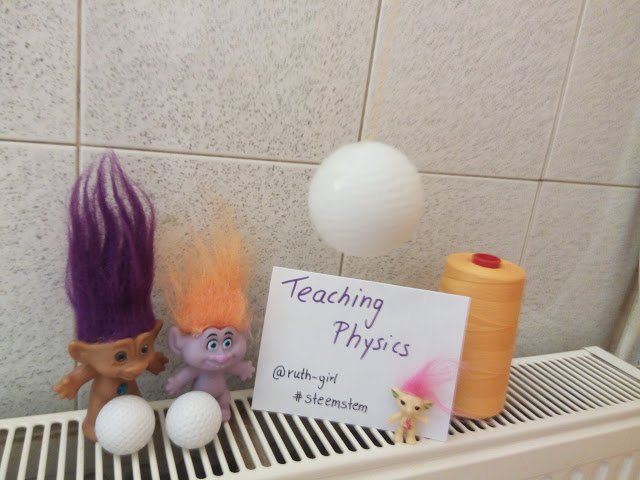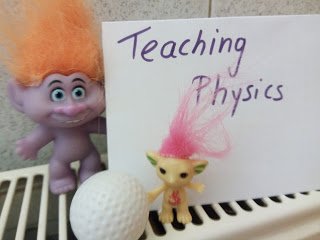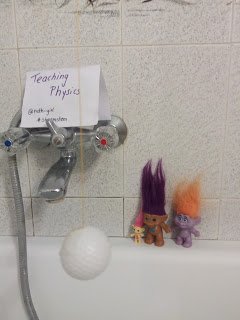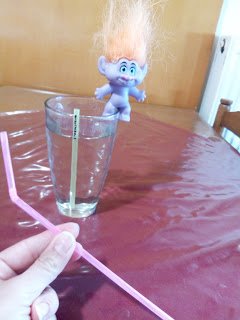I know you love them! I know you want them! I know you missed them! The troll team is back and got 3 easy experiments just for you today.
After having performed several experiments on air and liquid properties, this post will deal with fluid dynamics and will present you a simple and fun way to teach Bernoulli's principle in primary school children. So, get your hairdryers and follow me to the bathroom!

OBJECTIVES
Teach a basic principle of fluid dynamics, the field that studies the flow of fluids (both gases and liquids).
DETECTING FORMER KNOWLEDGE
Children might have noticed several appliances of this basic principle, birds and airplanes flying, bikers losing their balance when a car overdrives them very fast. By bringing such experiences to their attention you have the opportunity to explain why this happens, then present the theory and follow demonstrating the experiments below.
THE THEORY
Bernoulli's principle is simply summarized as: Within a flowing fluid (whether it be a gas or liquid) pressure decreases as its velocity increases and the other way round, pressure will increase if velocity decreases.
EXPERIMENT 1
Bernoulli's principle in liquids.
Materials:
- a ping pong ball
- some thread (20-30 cm will be enough)
- tape
- a tap


Procedure:
- Use the tape to fix the ball on the thread.
- Get the tap running.
- Hold the ball close to the water flowing downwards.
The ball is "attracted" by the water stream.
Conclusion: The pressure within the water flow is less than the surrounding air pressure, therefore the ball is "pushed" towards the water.
EXPERIMENT 2
Bernoulli's principle in gases.
Materials:
- a hairdryer
- a ping pong ball
Procedure:
- Switch the hair dryer on with the blower facing upwards.
- Place the ball over the blower.
The ball "dances" within the air flow.
Conclusion: The pressure within the air flow coming from the hairdryer is less than the surrounding air pressure, so the ball is "pushed" and kept within the air flow.
EXPERIMENT 3
Bernoulli's principle in gases.
Materials:
- a glass
- two straws
- tape
- water


Procedure:
- Cut off the drinking edge of one of the straws.
- Use tape to fix it in the glass (don't leave more than 2cm coming out of the glass).
- Fill the glass with water.
- Use the other straw to blow hard over the first one.
Drops of water start climbing through the straw that's inside the glass and "travel" in the air.
Conclusion: There is a flow of air over the straw that's in the glass. Within it the pressure is lower than the surrounding air pressure, this means that the air pressure over the surface of the water "pushes" the water in the straw to climb up. The drops are then scattered by the flow of air.
References
wikipedia.org
scienceclarified.com
Panagiotis Koumaras, "A guide to teaching physics through experiments" - Christodoulidis Editions (Thessaloniki 2005)
*Original picture at the end of this post by Nick Youngson (nyphotographic.com) - All other images by @ruth-girl

Thank you for being here and reading my post, perhaps some of you will find it interesting and give those experiments a try. If you do so, please leave a comment on how they worked for you and your class. You may also want to suggest any other experiments or projects to make this lesson even better. It would make me even happier if you were a parent and tried those simple experiments with your child/children, they are so simple, you can easily do them at home.
Perhaps you'd like to go through my blog, @ruth-girl, and discover plenty of educational posts along with my bizarre natural phenomena series.

Finally, the greek community of steemit is here and waiting for you to discover it! Follow the @greek-trail for daily doses of good-quality posts by wonderful writers!

Until my next post,
Steem on and keep smiling, people!




